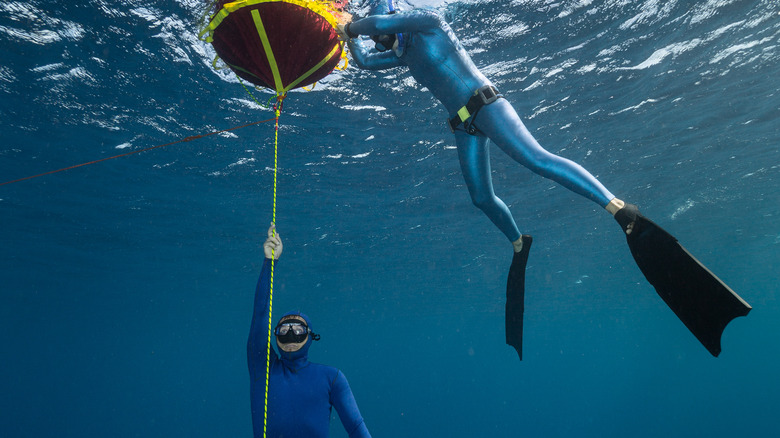Just How Deep Under Water Can A Human Go?
Atmospheric pressure sounds too boring to be scary, but if you've ever seen a fish pulled up from the depths of the sea that "popped" at the surface, with its bladder in its mouth and its eyes rolling out of the socket (like those pictured in this piece by Australia's ABC News), or seen a steel barrel crushed like a beer can by air pressure (as in this video by "Street Science," on the Science Channel, hosted on YouTube), you'll respect the power of this natural phenomenon.
As University of California, Santa Barbara's ScienceLine explains, the human body, like a fish, has evolved to match the pressure of the atmosphere around us. Since we live on land, at or close to sea level, this amounts to about 14.7 pounds per square inch. Our bodies are like balloons, inflated to exactly that pressure. If you somehow jumped out of a spaceship beyond Earth's atmosphere, without a space suit, your body would continue to exert that 14.7 lbs/inch pressure against ... nothing. You'd pop, in other words, like a deep sea fish brought to the surface. Likewise, if you swam deep into the ocean, the enormous weight of the sea could crush your body flat.
Under the sea
Obviously, a dip in the swimming pool isn't going to mash you into hamburger. Even swimming underwater in the sea won't necessarily hurt. The question is how deep into the sea a human can dive before the atmospheric pressure becomes too strong to withstand.
Medical Daily explains that for every 11 yards you descend in the ocean, this pressure increases by an incredible 15 lbs. per square inch. In other words, if you swim down to a depth about equal to a telephone pole (via Measuring Stuff), your internal pressure will only be half of the pressure exerted on your body. Consider, too, that your breathing is controlled by the flexion and relaxation of muscles. If you were squatting a heavy barbell, and it suddenly doubled its weight, you'd have a hard time standing up with it. At 11 yards, your diaphragm finds itself in the same situation. Breathing (assuming you had a long snorkel) would be hard.
But that's just the beginning. You could swim down three times deeper than that, where your lungs would begin to contract, and your heart rate drop. (This is called the mammalian dive reflex; humans and whales alike exhibit it.)
How deep is too deep?
You might be surprised to know that people can actually dive without too much trouble to 33 feet, or even to 100. They can even do it on a single breath. As a sport, this kind of deep, unassisted diving is called freediving. The fellow in the picture above guiding himself back to the surface after completing his dive? You'll notice he doesn't have an air tank.
There are a few limits on how far a freediver can go. One is time. Even with a deep breath and the various hyperventilation methods that freedivers employ (as described by Freedive Earth, and absolutely not recommended for beginners), your lungs can only hold so much oxygen. There will arrive a point when you run out. But the other, less obvious problem is atmospheric pressure. How deep can you go?
As it turns out, very, very deep. In 2012, Austrian Herbert Nitsch swam down to 830 feet off the coast of Santorini, in Greece. He secured the Guinness World Record, but at a cost: his case of the bends, or decompression sickness, was apparently "severe."


